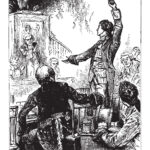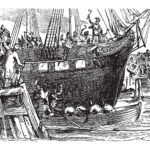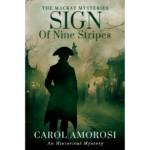 What is your first thought when you hear the Boston Tea Party? Well, yes, it took place in Boston. But many believe this started the American Revolution. And while it did trigger the uprising, trouble had been brewing long before the tea was dumped into the harbor. And Saturday, December 16th, is the 250th anniversary of that event. The American Revolution did not officially start until almost two years later, when shots were fired at Lexington and Concord on April 19, 1775. So why was the Boston Tea Party so important?
What is your first thought when you hear the Boston Tea Party? Well, yes, it took place in Boston. But many believe this started the American Revolution. And while it did trigger the uprising, trouble had been brewing long before the tea was dumped into the harbor. And Saturday, December 16th, is the 250th anniversary of that event. The American Revolution did not officially start until almost two years later, when shots were fired at Lexington and Concord on April 19, 1775. So why was the Boston Tea Party so important?
Two issues faced the Colonists at that point: their ongoing quarrel with the British East India Company and the continuing clash with Parliament over having to pay taxes while having no elected representatives. You have probably heard the rallying cry, “No Taxation without Representation.” These issues ultimately led to the showdown.
The East India Company was issued a monopoly for importing tea into England in 1698. When Englishmen took their preference for the beverage with them to the colonies, Parliament passed an act in 1721 designed to eliminate all competition in Britain. By extension, the colonists were also required to purchase their tea through the company. Technically, the East India Company sold the tea at auctions in England, and merchants sold it at markets in the principal seaports along the Atlantic Coast.
You can probably see where this is headed; there was a tax on the import into England before it was auctioned, and then it was taxed again when it arrived in the colonies. In addition, the merchants in England and those colonies wanted their fat profits. So when the Dutch Republic began selling tea with no added taxes, who can blame the people for buying the smuggled tea at a cheaper price?
 To attempt to compete with the smuggled tea, they passed the Indemnity Act in 1767. This Act lowered the tax on tea in an effort to wipe out illegal imports. Refunding the East India Company’s 25% tax created a loss on the tea re-exported to the colonies. Keeping an eye on the bottom line, Parliament hid the tax in the new Townshend Revenue Act of 1767, which taxed all goods imported from Britain. And so it continued…
To attempt to compete with the smuggled tea, they passed the Indemnity Act in 1767. This Act lowered the tax on tea in an effort to wipe out illegal imports. Refunding the East India Company’s 25% tax created a loss on the tea re-exported to the colonies. Keeping an eye on the bottom line, Parliament hid the tax in the new Townshend Revenue Act of 1767, which taxed all goods imported from Britain. And so it continued…
So, as I look back on the 250th anniversary of the Tea Party, here are some fun facts.
- Though it was tea that was dumped into the harbor following the Tea Act of 1773, the protest was not over tea. The new Act was a bailout for the East India Company, a corporate tax break, in other words. Parliament lowered the company’s taxes, which reduced the price of the tea and allowed them to undercut the smugglers. However, the duty required by the earlier Townshend Act, enacted without colonial consent, remained in effect. It was this principle that drove the Sons of Liberty to take action.

- Let’s stick it to King George. There is a popular misconception that a group of dissidents boarded the King’s ships and dumped his precious tea overboard. However, the Beaver, Dartmouth, and Eleanor were not English ships but were built and owned by Americans and operated under private contracts. The tea on board belonged to the East India Company and was transported on these merchant ships, two of which were whaling vessels that had delivered whale oil to Britain and were carrying tea on the return home.
- The tea was not Indian but Chinese. And much of it was green. The name is a bit of a misnomer as the company only exported spices and cotton from India while obtaining its tea from Canton. The East India Company did not set up its first tea plantation until the 1830s.
- Tea didn’t light the fire. You often hear that the Boston Tea Party was the rallying cry that ignited the colonists. However, while many prominent colonists argued against being taxed without representation in government, most abhorred the use of violence and malicious behavior, including damage to private property. George Washington was one among many who condemned the actions in Boston. It was Parliament’s reaction in 1774 that galvanized Americans. The Intolerable Acts, or the Coercive Acts, were a series of regulations intending to teach the rebellious children their place. It is no wonder these hit Massachusetts the hardest. Boston Harbor was closed, and men selected by the Crown replaced the elected local leaders. It also forced colonists to quarter members of the British troops in their homes. While many balked at the idea of being taxed with no say in Parliament, they were now messing with people’s lives and taking away rights they previously held. If it could happen in Boston, it could happen to me, became the prevailing belief.
- They dressed as “Indians,” so the indigenous people would take the blame. However, it is more likely the Sons of Liberty blackened their faces and carried
 tomahawks to mask their own identities. Many historians today believe they were taking advantage of the independent spirit of the native people, saying, “We are independent. We are in defiance. We will not be defeated.” Besides, they were, after all, committing a crime.
tomahawks to mask their own identities. Many historians today believe they were taking advantage of the independent spirit of the native people, saying, “We are independent. We are in defiance. We will not be defeated.” Besides, they were, after all, committing a crime. - They did not call it a tea party. The first time the name Boston Tea Party appeared in print was in 1825, and it seems the word party referred to a collection or group of men, not a celebration, as we think today. Besides, the British concept of tea parties didn’t take hold until after Lewis Carroll’s Alice in Wonderland was written in 1865. They gained their highest popularity in the Victorian era.
- The Boston Tea Party wasn’t the only one. Three months later, men in disguise boarded the Fortune in Boston, dumping three chests of tea overboard. Additional “parties” occurred throughout 1774 in New York, Annapolis, and Charleston.

- Only one man was injured. Initially thought to have been killed, John Crane rose from the dead several hours after being knocked unconscious by a falling crate. His fellow patriots hid his body under a pile of wood shavings in a nearby carpenter’s shop. He has the dubious honor of being the only man harmed during the Boston Tea Party.
I hope you’ve enjoyed celebrating the anniversary of this event and maybe learned something you didn’t know before. The events leading up to the Revolution affected everyone, as they often argued with their neighbors, their fellow English settlers. Over one-third of the colonists fought for England in the war. Each man had to decide for himself which side he supported.
 I rarely promote my books in the articles I write on this page. However, if you are interested in one man’s journey toward that decision, check out my novel, Sign of Nine Stripes.
I rarely promote my books in the articles I write on this page. However, if you are interested in one man’s journey toward that decision, check out my novel, Sign of Nine Stripes.
